
Orthoptera is an order of insects that comprises the grasshoppers, locusts, and crickets, including closely related insects, such as the bush crickets or katydids and wētā. The order is subdivided into two suborders: Caelifera – grasshoppers, locusts, and close relatives; and Ensifera – crickets and close relatives.
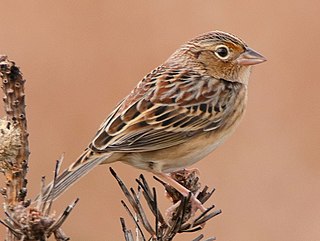
The grasshopper sparrow is a small New World sparrow. It belongs to the genus Ammodramus, which contains three species that inhabit grasslands and prairies. Grasshopper sparrows are sometimes found in crop fields and they will readily colonize reclaimed grassland. In the core of their range, grasshopper sparrows are dependent upon large areas of grassland where they avoid trees and shrubs. They seek out heterogenous patches of prairie that contain clumps of dead grass or other vegetation where they conceal their nest, and also contain barer ground where they forage for insects, spiders, and seeds. Grasshopper sparrows are unusual among New World sparrows in that they sing two distinct song types, the prevalence of which varies with the nesting cycle. The primary male song, a high trill preceded by a stereotyped series of short chips, is reminiscent of the sounds of grasshoppers and is the origin of this species' name. Like some other birds of the central North American grasslands, this species also moves around a lot, not only via annual migrations, but individuals frequently disperse between breeding attempts or breeding seasons. Grasshopper sparrows are in steep decline across their range, even in the core of the breeding distribution in the tallgrass prairies of the central Great Plains. The Florida grasshopper sparrow is highly endangered.
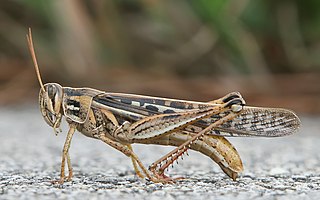
Grasshoppers are a group of insects belonging to the suborder Caelifera. They are among what is possibly the most ancient living group of chewing herbivorous insects, dating back to the early Triassic around 250 million years ago.
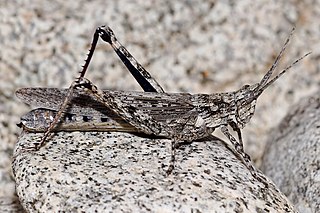
Acrididae, commonly called short-horned grasshoppers, are the predominant family of grasshoppers, comprising some 10,000 of the 11,000 species of the entire suborder Caelifera. The Acrididae are best known because all locusts are of the Acrididae. The subfamily Oedipodinae is sometimes classified as a distinct family Oedipodidae in the superfamily Acridoidea. Acrididae grasshoppers are characterized by relatively short and stout antennae, and tympana on the side of the first abdominal segment.
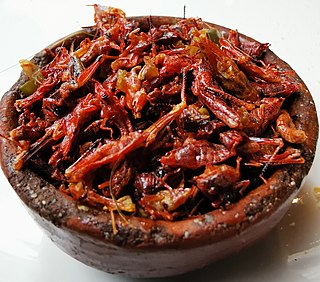
Chapulines, plural for chapulín, are grasshoppers of the genus Sphenarium that are commonly eaten in certain areas of Mexico. The term is specific to Mexico and Central America, and derives from the Nahuatl word chapolin (singular) or chapolimeh (plural).

The Caelifera are a suborder of orthopteran insects. They include the grasshoppers and grasshopper-like insects, as well as other superfamilies classified with them: the ground-hoppers (Tetrigoidea) and pygmy mole crickets (Tridactyloidea). The latter should not be confused with the mole crickets (Gryllotalpidae), which belong to the other Orthopteran sub-order Ensifera.
Appalachia arcana is a species of grasshopper in the family Acrididae. It is known by the common names Michigan bog grasshopper and secretive locust. It is the only grasshopper that is endemic to Michigan in the United States.

Low Maynard Reservoir is located in Walthamstow in the London Borough of Waltham Forest. The storage reservoir is part of the Lee Valley Reservoir Chain and supplies drinking water to London.
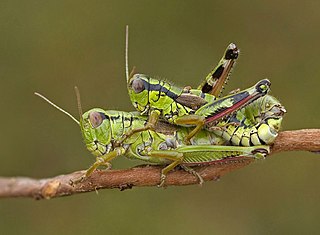
Acridoidea is the largest superfamily of grasshoppers in the order Orthoptera with species found on every continent except Antarctica.
Mesogondolella is an extinct genus of conodonts.
Encoptolophus is a genus of band-winged grasshoppers in the family Acrididae. There are about 8 described species in Encoptolophus.
Encoptolophus subgracilis, the southwestern dusky grasshopper, is a species of band-winged grasshopper in the family Acrididae. It is found in North America.
Aztecacris gloriosa, the atascosa gem grasshopper, is a species of spur-throated grasshopper in the family Acrididae. It is found in the southwestern United States and Mexico.

Metaleptea is a genus of short-horned grasshoppers in the family Acrididae. There are at least two described species in Metaleptea, found in North, Central, and South America.

Nebulatettix is a genus of band-winged grasshoppers in the family Acrididae. There are at least three described species in Nebulatettix, found in North America.
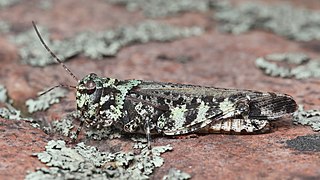
Spharagemon marmorata, the marbled grasshopper, is a species of band-winged grasshopper in the family Acrididae. It is found in eastern North America.

Hypochlora alba, known generally as mugwort grasshopper, is a species of spur-throated grasshopper in the family Acrididae. Other common names include the sage grasshopper and cudweed grasshopper. It is found in North America. It feeds exclusively on Artemisia ludoviciana.
Nebulatettix pallidus is a species of band-winged grasshopper in the family Acrididae. It is found in western North America.

Stethophyma gracile, known generally as the graceful sedge grasshopper or northern sedge grasshopper, is a species of band-winged grasshopper in the family Acrididae. It is found in North America.

Grasshopper was an app developed by Google that taught users to code with JavaScript. Available for IOS and Android operating systems, the program had aimed to teach with small "bite-size" coding lessons. The program got harder as it progressed, and upon finishing the program, the user was given a certificate of completion. Assessments were not required to gain the certificate of completion.













